




 Recommended Puppy Supplies Checklist
Recommended Puppy Supplies ChecklistWe’ve been raising dogs for the past 15 years so needless to say, we’ve also purchased a lot of puppy supplies!
Some have helped to make our lives easier and our house run smoother… while others were a huge waste of money.
Hopefully this page will help you to save some money and time as well!
I’ve ALREADY done all the research for you!!

All these Products qualify for Amazon Prime – Free 2-day shipping!
![]()
Believe it or not, this is one of my Holy Grail Puppy Products!
I’ve purchased every size of these rugs and they all work great in the house but can also be used in a truck bed or dog crate!
Here in the Great Northwest we get a lot of RAIN and MUD so these rugs have been really helpful with our 5 adult dogs and countless puppies over the years and helped to save my floors and my sanity!
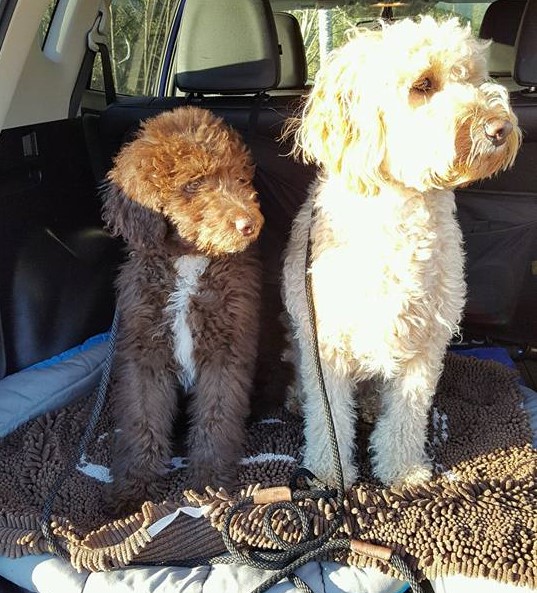 Buy your Soggy Dog Rugs on Amazon!
Buy your Soggy Dog Rugs on Amazon!
Buy your Soggy Dog Rugs on Chewy.com!
Any size will be work for your Doodles and they are a worthy investment!
Check both websites for the best prices!
 I’d never insist you feed your Dreamydoodle a specific brand of Dog Food… I only ask that you feed them a high-quality food and recommend a few!
I’d never insist you feed your Dreamydoodle a specific brand of Dog Food… I only ask that you feed them a high-quality food and recommend a few!
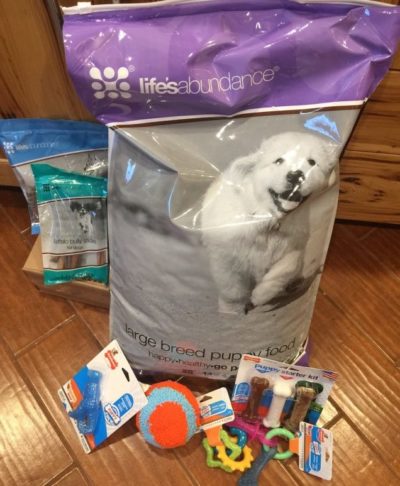 Life’s Abundance – Dog Food
Life’s Abundance – Dog FoodLife’s Abundance – All Life Stages – This food was a game changer for my dogs at one point when I couldn’t find a food that all my dogs would eat – consistently.
When you get a puppy from Dreamydoodles we give you 1 weeks worth of their puppy food but recommend you also either have their food at home or you’ve ordered it and it’s on the way when you bring them home.
Life Abundance is Only Available at MyPuppyFood.com
ORDER YOUR DREAMYDOODLE PUPPY’S FOOD TODAY!

Another high-quality dog food formula I recommend would be Purina Pro Plan –Shredded Formulas and yes, it has to be one of their “Shredded formulas” (according to my dogs taste buds)

 100% digestible, all-natural alternative to rawhides and great for teething puppies but can also help to keep a bored, anxious or training puppy preoccupied!!
100% digestible, all-natural alternative to rawhides and great for teething puppies but can also help to keep a bored, anxious or training puppy preoccupied!!
These are stretched and baked cow esophagus (throats), and each piece is approximately 6″ long and varying thickness.
You can either buy SIX Bully Sticks at Petsmart for $32 bucks!!! Or FIFTY Gullet Sticks @ Chewy.com or Amazon Prime for the same price!
And Yes, I do recommend buying FIFTY of them for your teething puppies!!!
Just Don’t overdo it! 1-2 a day!
*For adult dogs, the gullet sticks will usually be gone in only a few crunches so, bully sticks or real bones are better for adults – Check out the Best Bully Sticks on Amazon!
COMPARE PRICES ON CHEWY AND AMAZON!
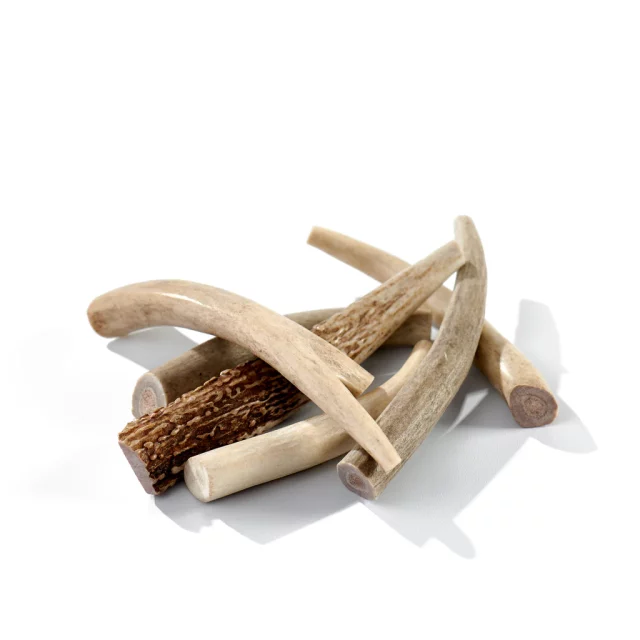 Antlers for Dogs
Antlers for DogsPuppies and Adult Dogs both LOVE Antlers and Don’t worry your puppy CAN chew an antler no problems!
Antlers are a much harder chew but they never seem to hurt the puppy’s teeth and while they are not cheap – they LAST FOREVER!! Like months!
COMPARE PRICES ON CHEWY AND AMAZON!

I’ve always loved Greenies but they never recommended them for puppies… well now they have Puppy Greenies! 50% softer than Original Greenies! Veterinarian-recommended dental treats.
COMPARE PRICES ON CHEWY AND AMAZON!

SmartSticks chews are rawhide-free, made with real chicken, and vegetables! They provide your puppy with needed chewing exercises. SmartBones are 99.2% digestible, which is even higher than premium dog foods (85% digestibility)!
COMPARE PRICES ON CHEWY AND AMAZON!
 POOCHIE POWDER
POOCHIE POWDERThe wildly popular Organic Dog Food Multivitamin Supplement “Poochie Powder”! The company owner put her own Dreamydoodle pup “Hugo” on the bag!
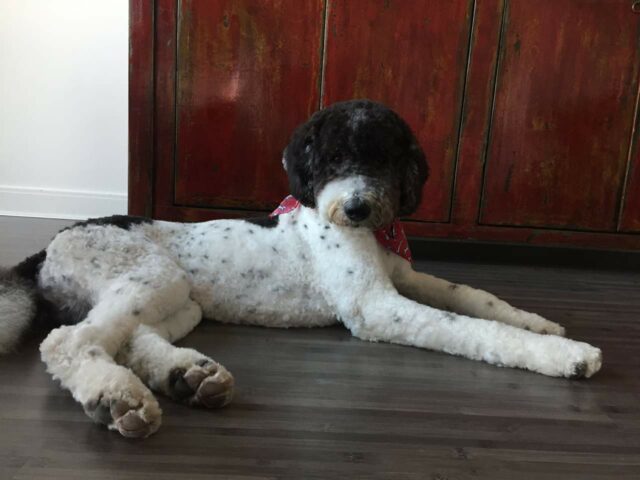 Poochie powder is a RAW Superfood Powder with Essential Vitamins, Minerals, Wild Blueberries, Parsley, Antioxidants, and much more.
Poochie powder is a RAW Superfood Powder with Essential Vitamins, Minerals, Wild Blueberries, Parsley, Antioxidants, and much more.
Just add a scoop to their kibble with some warm water, mix it up and chow it down.
Buy Poochie Power on Amazon Prime!
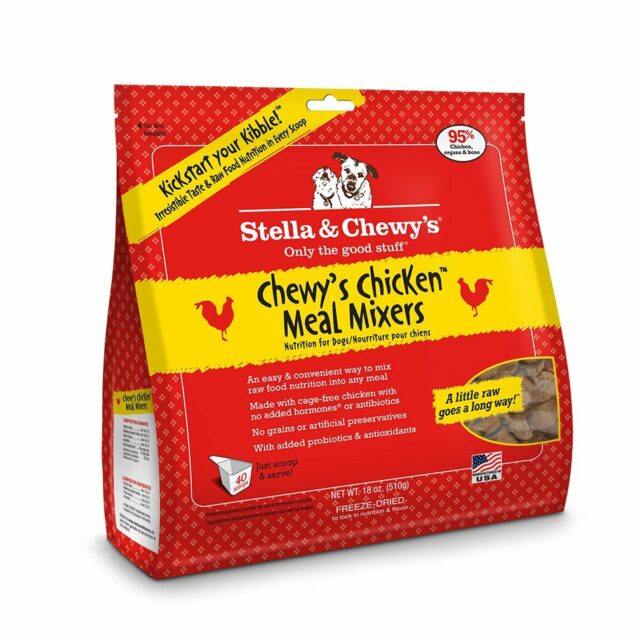 STELLA AND CHEWIES – MEAL TOPPERS
STELLA AND CHEWIES – MEAL TOPPERSAnother yummy meal topper is Stella and Chewy’s – A raw dehydrated chicken meal topper mixed in with their kibble and warm water.
Top your puppy’s meals with Whole pieces of Freeze Dried Chicken! They also sell dehydrated chicken patties.
Buy Stella and Chewy’s on Chewy.com!
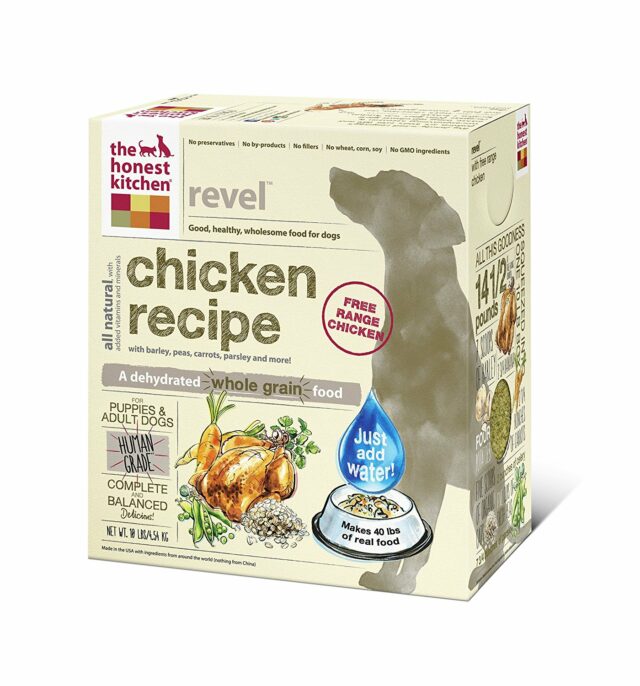
Another great option is the Honest Kitchen Raw dehydrated dog food! You just mix it in warm water and add it to your dog’s kibble or feed it alone.
A 10 lb box makes 40 lbs of dog food! Even my pickiest dogs lick the bowl clean!
Buy Honest Kitchen Free Range Chicken Formula on Chewy.com!
Stainless steel is the #1 choice of vets. Stainless steel bowls are easy to clean and sanitize as they dont harbor bacteria like plastic can and they can’t be chewed up by teething puppies either.
Our Pets Durapet Stainless Steel Bowl, 4 Cup s, 6.9″X6.9″ X2.5″
Compare Prices on Chewy and Amazon!

 CRATES, BABY GATES, AND PUPPY PENS
CRATES, BABY GATES, AND PUPPY PENS✔ Separation Anxiety is the #1 reason puppies and dogs are relinquished to the pound or rehomed.
✔ Crates keep puppies safe when you can’t supervise them.
✔ Crate training teaches puppies how to self-soothe! – being left alone simply isn’t natural for puppies or adult dogs. The natural instinct of a puppy is to stay close to its pack members or family members not only for safety reasons but for basic survival. I believe they wanna be with us because they love us, but either way, this instinct to stay close seems to be very STRONG, especially, for puppies.
✔ Puppies can hold it twice as long in the crate at night if they’re on a strict potty, sleeping, and feeding schedule!
✔ CHECK OUT OUR CRATE TRAINING SCHEDULES!

I recommend the Midwest iCrate or the Midwest Life Stages Crate
A larger size crate can be purchased and used from Puppy to Adulthood as long as you use the wire divider to make it smaller for crate training.

This is an example of how much space a dog or puppy needs in the crate! No More! No Less!
 The Perfect Crate Size for Potty Training?
The Perfect Crate Size for Potty Training?Crate Training is basically a training trick!
We’re using the dog’s natural instincts to help us potty train them.
The Dog’s natural instinct is….. NOT TO GO POTTY WHERE THEY SLEEP OR EAT!
Possibly the biggest mistake people make when buying a crate is to buy one too large, thinking they’re doing their dogs a favor by buying them extra room.
Ok, so how big does it need to be? Your dog needs to be able to sit up straight without banging their head on the ceiling, be able to turn around, and lay down on their side with their paws outstretched without being cramped.
If you put them on a strict feeding/drinking and sleeping schedule it will give you more control over when they need to go.
Crate training becomes a whole lot easier if you follow these instructions!

FOR OUR MINI-SIZE PUPPY Dimensions: (24″L x 18″W x 19″H comes w/wire divider) |
|
|
Dimensions: ( 30″L x 19″W x 21″H comes w/wire divider) |
|
|
The 36-inch Midwest iCrate Pet Crate Dimensions: (36″L x 23″W x 25″H comes w/wire divider) |
|
|
The 42-inch Midwest iCrate Pet Crate Dimensions: ( 42″L x 28″W x 30″H – comes w/wire divider) |
You want your puppy to be able to see what’s going on in their new house and not to feel isolated so keep the crate wherever you’re spending the most time during the day and you can also move it to the side of your bed (in arm’s reach) at night. This helps keep the puppy much calmer, especially during the first couple of nights of crate training.
Some people will also put a cover over their metal crates to give their puppy a more den-like “feeling”.
If your puppy goes potty on the crate mat, just remove it.

It only takes a few days for Puppies to start relaxing and go to sleep without whining or crying first… but this happens only if YOU CAN STAY CONSISTENT and if you don’t let them out before the magic happens!
If you let a puppy out of the crate when they’re crying… they’ll continue to cry every time you put them in because now they’ve figured out what works and how to get you to obey their commands. Just make sure there’s a break in their crying before you let them out and then YOU’LL be training THEM instead of them training you!
When we’re crate training we give them a chew toy or a stuffed animal. Nothing else. We also remove beds or blankets if they start using them as potty pads! You can give them back once your puppy is potty trained.
 Petmate Sky Kennel for Pets for dogs 25 to 30-Pounds
Petmate Sky Kennel for Pets for dogs 25 to 30-Pounds
Dimensions: 28 x 20.5 x 21.5 inches
INSTALL A DOGGY DOOR AND NEVER worry again about letting your puppy out in time. Total freedom for everyone involved! Puppies can learn to use doggy doors VERY quickly too!!

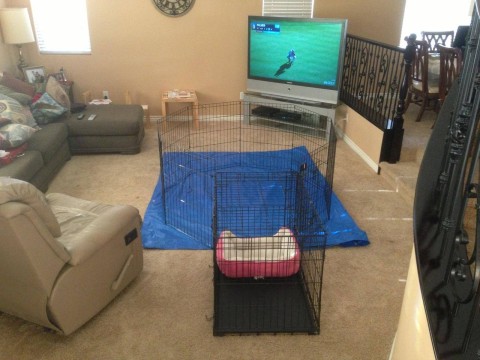 For people who can’t take a puppy out of the crate every 2-3 hours, I recommend an xpen setup – an enclosure with access to a litter box or potty area at least until they’re old enough to hold it for a full 8-hour work day.
For people who can’t take a puppy out of the crate every 2-3 hours, I recommend an xpen setup – an enclosure with access to a litter box or potty area at least until they’re old enough to hold it for a full 8-hour work day.
You can use either baby gates to block off a room or an x-pen with a crate inside. I like to put a plastic tarp (as seen in these pictures) under the x-pen. You can either use a puppy potty box, doggy lawn, cloth pads, newspaper, or potty pads. There are artificial grass and real grass patch options nowadays too.
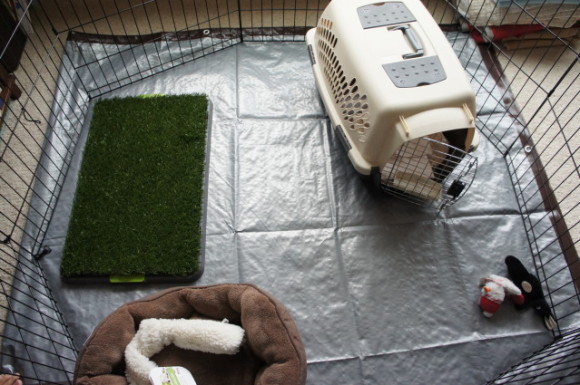
 PetSafe Pet Loo Portable Indoor/Outdoor Dog Potty, Alternative to Puppy Pads, 3 Size Options for Small to Large Breeds
PetSafe Pet Loo Portable Indoor/Outdoor Dog Potty, Alternative to Puppy Pads, 3 Size Options for Small to Large Breeds
I’ve never used grass patches in an xpen but they do sound nice if cared for properly I think they could actually work out pretty well for a short period while you’re potty training your puppy to go outside but personally, I wouldn’t want to depend on these for a long-term solution.
THIS ONE HAD THE BEST CUSTOMER REVIEWS
 WHAT ABOUT POTTY PADS?
WHAT ABOUT POTTY PADS? 
Young puppies love to chew up commercial-made puppy pads which will cause a huge mess and that defeats the purpose, plus buying these every week can get very spendy and bad for the environment.
So, if you absolutely must use potty pads then I HIGHLY recommend you use the cloth pads aka incontinence pads instead. You can get these for extremely cheap online at medical suppliers or on Amazon. I get the 33 x 36-inch pads and the 23 x 36 size!!
The bigger ones are perfect for the x.pen setups. I personally use these in my bedroom. If you’ve been here then you’ve probably seen them.
Buy these Cloth Pads on Amazon!
 WHAT YOU NEED FOR AN X-PEN SETUP
WHAT YOU NEED FOR AN X-PEN SETUPBlog post: Crate and X-Pen Setups – Click Here!
I use these under the x-pens – Poly Tarp 8′ x 10′ – Durable, Water Resistant
These pans are BIGGER than most Litter Boxes for Cats.
| Puppy Go Here – Litter Box on Amazon! |
 Puppy Litter – Paper Pellets
Puppy Litter – Paper PelletsBuy So Phresh Dog Litter with Odor Control Paper, 18 LBS on Amazon!
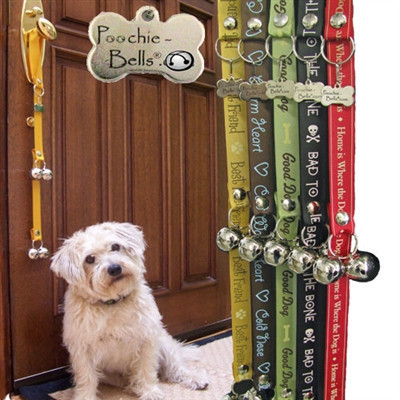 POOCHIE BELLS
POOCHIE BELLSA lot of our families use Poochie Bells with GREAT success!
Teaching them how to notify you when they have to “go potty” is HALF the battle.
IF YOU HAVE A PUPPY – YOU’LL WANT SOME PUPPY GATES!!
Once I found the extra tall gates! I was SOLD FOR LIFE! But believe me, I wasted SO bunch of money on some crappy gates first. Hopefully, this list will help to save you money!
AMAZON LINKS:
They come with one extender piece but you can buy extra extensions if you need it for the wider hallways or doors.
Or they have extra wide options as well.
AMAZON LINK: Carlson Extra Wide Pet Gate Size: 36 x 29 inches

The Mopnado is HEAVEN SENT!!!
If you own a dog, you need the Queen of Mops!
I got this mop on Amazon (as usual) and it comes with 2 Microfiber Mop Heads and 1 scrub brush and an awesome and sturdy spin bucket.
Well worth the price!
Buy The Mopnado Mop on Amazon!
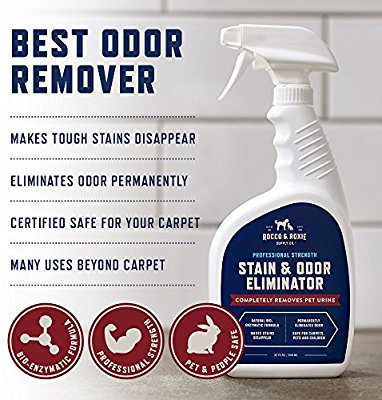 Rocco & Roxie Stain & Odor Eliminator Spray
Rocco & Roxie Stain & Odor Eliminator SprayRocco & Roxie – ELIMINATES STAINS, ODORS, AND RESIDUE If it’s gross, it’s gone. Not just the stain, but the stink. From stinky yellow pet urine and feces to vomit and other organic spills, our professional strength formula tackles them all.
More Stain Removers that work on Potty Accidents
DON’T BUY A FANCY EXPENSIVE DOG BED UNTIL THEY GET PAST THE PUPPY STAGE
I like these beds because they are cute AND cheap so if they chew it up, just buy another one without spending a bunch of money.
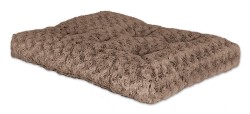
MidwestQuiet Time Bolster Pet Bed, Fleece
These fit perfectly in a Midwest ct a standard-size pillow works too
If you really want to spoil your new puppy these donut beds are the way to go!
Dogs LOVE these beds!!!!! I’ve purchased this one Multiple times!
ORTHOPEDIC XL MEMORY FOAM DOG BEDS (FITS A 48 INCH CRATE):
If you want an extra large or waterproof bed for the deck – I got this one and my dogs LOVED it plus 3 of them could fit on it at the same time!!
Puppies love to cuddle up with a super soft blanket! I purchased these on Amazon for years. Highly Recommended.
They have a couple of different prints! I’ve linked the best deals.
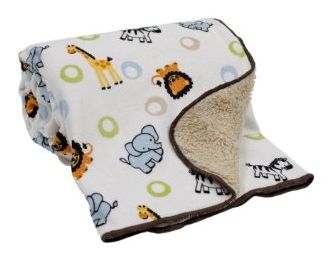 |
Bedtime Originals – Jungle Buddies Velour Sherpa Blanket |
 |
Lambs & Ivy – Little Woodland Forest Animals Blanket, Pink/White |
 Road Trip Puppy Tools!
Road Trip Puppy Tools!For a much safer road trip.
Cute picture but obviously not practical… But you can get individual seat belt connectors for your dog on Amazon.
You just click one side onto your Dog’s HARNESS OR COLLAR and the other side goes into your seat belt connector.
 |
Basically, these come down to personal preference so anything that works will do just fine when it comes to these two tools but here are some good places to start!
Do NOT use a Retractable Dog Leash. Dangerous and also limit the control of your puppy or dog, defeating the purpose.
A standard 6-foot nylon leash works great!

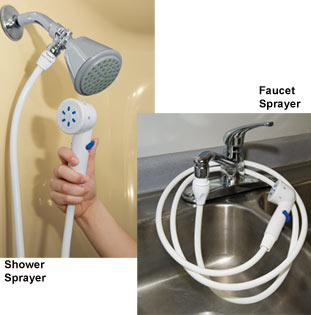 Rinse Ace 3-Way Shower Sprayer Dog Grooming Tool, 8-ft hose
Rinse Ace 3-Way Shower Sprayer Dog Grooming Tool, 8-ft hose
 BRUSHING YOUR LABRADOODLE
BRUSHING YOUR LABRADOODLEThis brush is considered the absolute best by every groomer and Doodle breeder/owner I’ve ever asked. The cost may deter you, especially when other slicker brushes are so much cheaper, but every part of this brush is designed to make grooming comfortable for you and your dog.
The Chris Christensen Long Pin Slicker Brush
You need a good slicker brush so if you can’t buy one of the Christenson brushes. Get one of these:
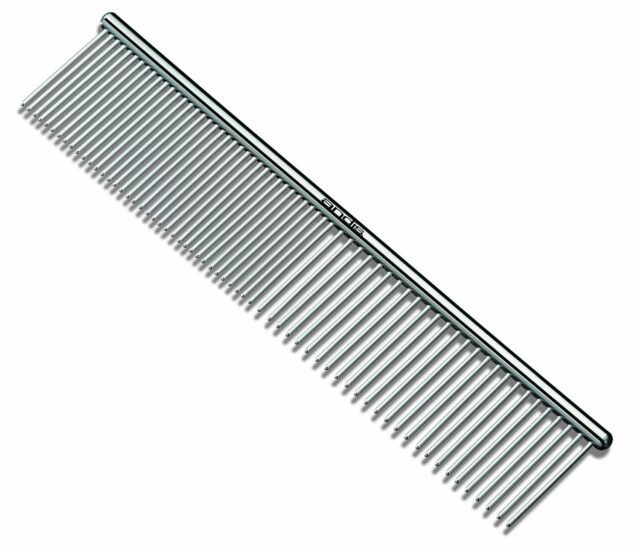 Andie Steel Grooming Comb
Andie Steel Grooming CombAndis Steel Grooming Comb – My “seek and destroy” tool, I glide this through their coat with the long pinned Andis comb to find any hidden mats.
When grooming a Doodle or Poodles the most common mistake is brushing over the top of the coat only and not from root to tip. Another mistake is washing them at home but not brushing them out completely afterward. Water tightens any mats that they have so it’s important to comb them and blow dry them if possible.

You can use something like the Tropiclean D-Mat Spray to help brush them out while reviving their coats, restoring elasticity, and leaving hair with a healthy shine.
This is not a pic of an abused Goldendoodle off the street… nope, this is a Goldendoodle who hasn’t been combed properly maybe for a few months, it doesn’t take long to get bad.
Invest in a nice set of Clipper’s like the Andis Super 2-Speed AG Clipper w/#10 Blade and learn, this will save you hundreds of dollars a year just get prepared for some funny haircuts.
Grooming clippers used in the video: Wahl Professional 2 Speed Corded Clipper Kit
READ MORE ABOUT: Grooming the Labradoodle, Goldendoodle & Aussiedoodle
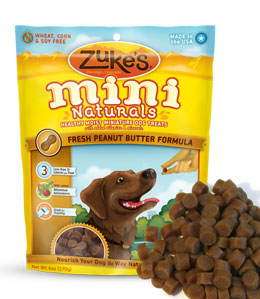 PUPPY TRAINING TREATS
PUPPY TRAINING TREATSTry to stay away from rawhide & go for the natural bones if possible… Never feed cooked bones to your dogs or puppies. Some RAW bones are OK.
Suitable Natural Bones found at the supermarket would be:
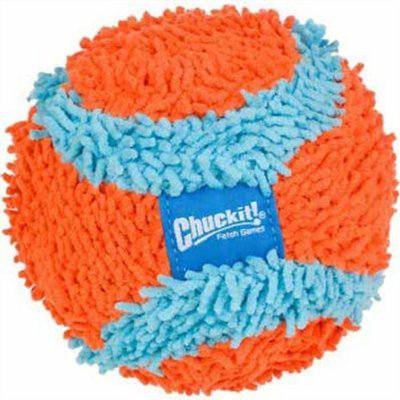
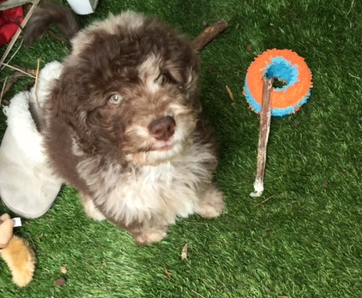 Chuckit! – Indoor Balls
Chuckit! – Indoor BallsBest Dog present ever.. these balls are These toys are BIG & STURDY and last FOREVER and I’ve purchased them many times!
They also make the Chuckit! Indoor Roller and with the Indoor Launcher as well!
Buy The Chuckit Indoor Ball on Amazon!
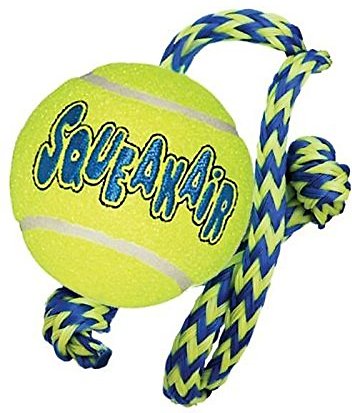 KONG SqueakAir Ball and Rope Toy
KONG SqueakAir Ball and Rope ToyThe KONG AirDog Squeakair Ball w/ Rope combines two classic dog toys” the tennis ball and the squeaker toy, plus a strong rope” to create the perfect fetch toy.
Safe-Guard (Fenbendazole) is an over-the-counter medication that comes with 3 powder packets that you sprinkle over their food. This is the same drug Vets will perscribe you if you took them into the clinic so save yourself some money and just buy it online or at the Pet Store.
Treatment for Worms is 1 pack a day for 3 days in a row, every 3-6 months. Each box includes 3 packets.
Buy Safe-Guard On Amazon – BASED ON YOUR DOGS WEIGHT.
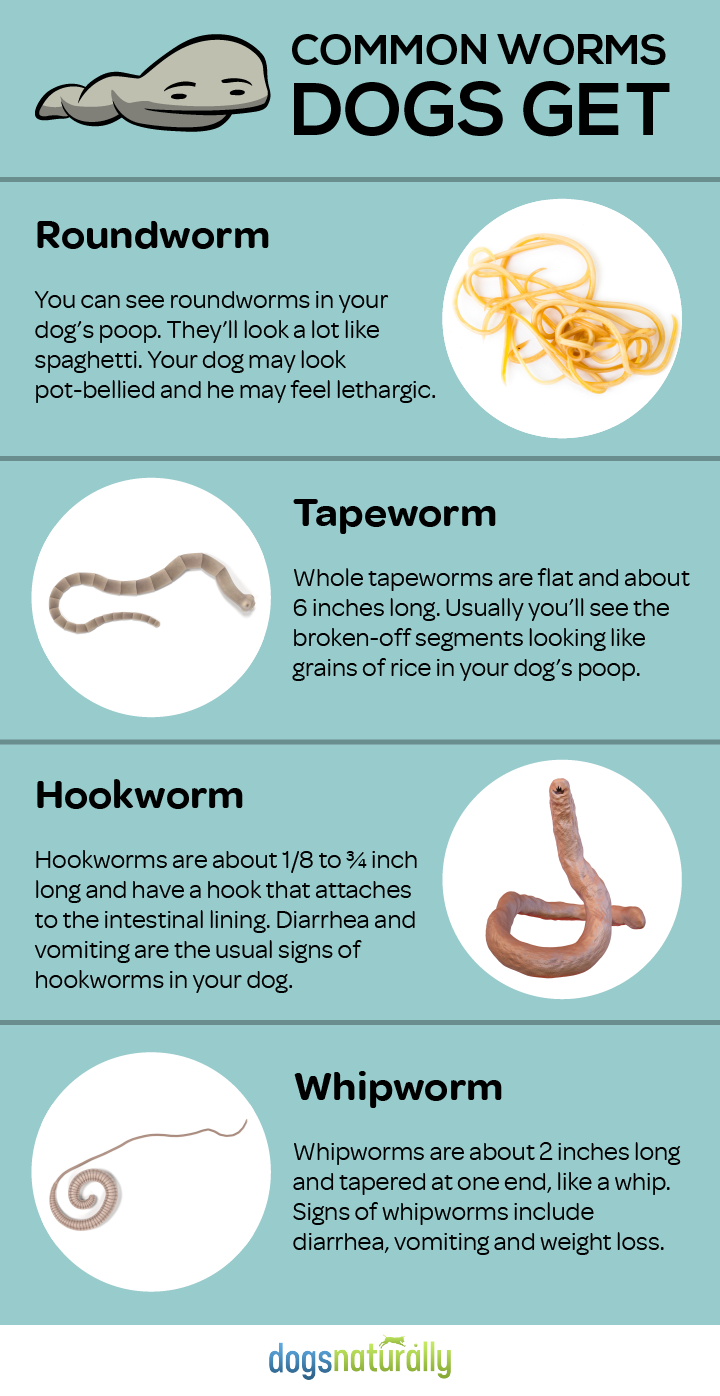 More About Dog Parasites and Giardia
More About Dog Parasites and Giardia Safe-Guard covers the 4 most common intestinal parasites plus Giardia which is a common intestinal disease especially for young puppies because they dont have any immunities to it yet. Adult dogs will eventually gain some Immunity to it and it doesn’t effect them as bad but that also tells us how common it is!
Some common places they may contract parasites are dog parks, the groomers, the Vet clinic floors and their grass areas, beaches, camping grounds, pet stores, or drinking out of contaminated rain puddles. Basically anywhere where an infected dog could of gone potty.
But… Don’t keep them home…just deworm them regularly.
Also, Intestinal Parasites don’t always cause really noticeable symptoms in dogs (unless it’s really bad) so don’t wait to treat them when they show symptoms instead you should deworm them with Safe-guard every 3 months to keep them healthy.
I use Nuvet Plus as a daily vitamin which strengthens their immune systems and helps them with their overall development and health and then I’ll use salmon oil which is rich in Omega 3 for their coat, joint and brain health and if they’re having intestinal issues or taking a course of antibiotics then I’ll also use Fortiflora which is a Probiotic or the Nutramax Proviable – Probiotics and these can be used short-term but if your dog has reoccurring intestinal issues you can use these long-term too.
Read our Post on The Best Toys for Doodles!